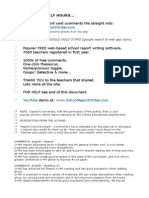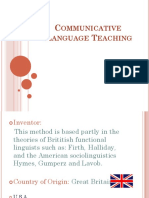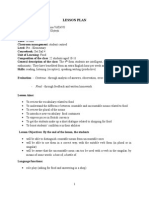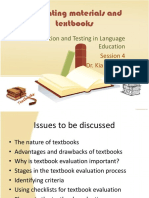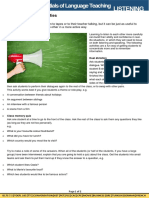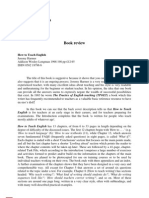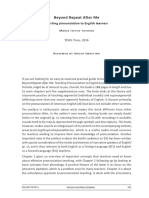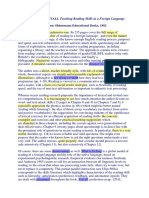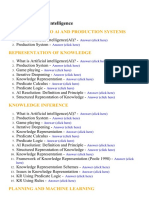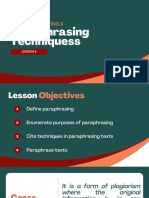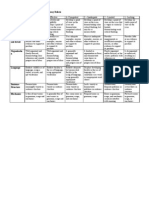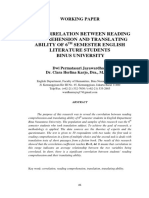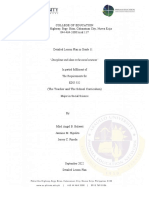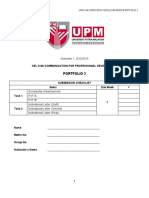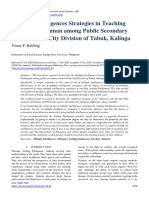Review Jeremy Harmer How To
Review Jeremy Harmer How To
Uploaded by
Oscar Balderas ZamoraCopyright:
Available Formats
Review Jeremy Harmer How To
Review Jeremy Harmer How To
Uploaded by
Oscar Balderas ZamoraCopyright
Available Formats
Share this document
Did you find this document useful?
Is this content inappropriate?
Copyright:
Available Formats
Review Jeremy Harmer How To
Review Jeremy Harmer How To
Uploaded by
Oscar Balderas ZamoraCopyright:
Available Formats
Reviews
How to Teach English Jeremy Harmer Addison Wesley Longman ISBN 0582 19796 6 reader to where the chapter contents will be taken up later. These are followed by a 41-page, chapter-related Task File, which according to the introduction (p.ix) 'comprises a large number of exercises and activities designed to predict and/or build on the information in the chapters of the main book. These are intended to be photocopied for use on training courses or to be used by individual teachers working on their own'. The book ends with three appendices and an index.
1998 198 pp 12.95
A closer examination of the chapters shows that they have been designed in a very user-friendly way. All except for the long Chapter 5 answer a set of around six questions related to the topic Knowing what Harmer has produced of this kind under scrutiny. For example, Chapter 8 ('How to in the past ('the highly acclaimed and ever popular teach writing') has sections headed: 'Why teach The Practice of English Teaching' (TPOET), also writing?'; 'What kind of writing should students Longman (1983, revised 1991)), a book which this do?'; 'What do writing sequences look like?'; reviewer has frequently recommended to teachers 'How should teachers correct writing?', and so on. as a valuable basic reference resource to have on Most of these sections are around one page long, one's ELT shelf, I approached the new book written in a very clear style, often with subrather less circumspectly than I might otherwise headings, and with plenty of well-described have done. practical examples. The descriptive framework adopted is an ESA (Engage-Study-Activate) What are we getting here, and how is it different from TPOET? As far as the intended readership is sequence. concerned, the back cover blurb tells us that How Harmer describes this sequence (p. 32) as 'the to Teach English is for teachers at an early stage in basic building blocks for successful language their careers, and for teachers preparing for teaching and learning'. In its 'straight-line' format, examinations such as The Certificate in English esa is like the classic Present-Practice-Production Language Teaching to Adults or The Certificate in TESOL'. The Introduction (p. ix) adds that the (PPP) (or Scrivener's Clarification and Focusbook 'is written for people who teach mostly Restricted Use-Authentic Use (CRA) (Scrivener adults of whatever age'. This sounds as if its 1994: 133-8)). Unlike PPP, Harmer suggests, and aimdespite UCLES/RSA and Trinity College's later exemplifies, that the 'S-A' parts of his best efforts at opening up their qualification formula can be modified as appropriate once the courses to all-comersis slanted towards those students are emotionally engaged, and he offers native-speaker teachers working in private lan- an EAASASEA 'patchwork' lesson plan (p. 29). guage schools. Whereas TPOET, according to the Whilst appreciating that the 'E' always comes first, Longman catalogue, is 'a complete reference work and that this is a very student-centred model, ESA is patently a much broader lesson-planning device for all teachers of English'. than Scrivener's ARC descriptions. As such, it is How to Teach English has 13 chapters, of from 6 safer and more easily applicable for beginner to 33 pages in length. The first 12 all begin with teachers, although rather less useful in practical 'How to . . . ' (e.g. 'How to teach reading' (7); terms. 'How to plan lessons' (12), while Chapter 13, which answers seven fundamental FAQS (fre- ESA is introduced in Chapter 4 ('How to describe quently asked questions) in eight pages, is called teaching and learning') and used thereafter to 'What if?' Each chapter is followed by a short demonstrate how lessons might work for reading 'Conclusions' section that rounds up the main (Chapter 7), writing (Chapter 8), speaking (Chappoints made, and all but the last chapter have a ter 9), and listening (Chapter 10). Examples are shorter 'Looking ahead' section which points the laid out most specifically on pp. 64-6.
ELT Journal Volume 54/3 July 2000 Oxford University Press 2000
This is one of the new, and for me, rather unfortunately titled books in the Longman 'How to . . . ' series (a stable-mate to How to Use the Internet in ELT and How to Teach Grammar). In an ELT world which is able to embrace everything from Berlitz and the other widespread method schools, to Suggestopedia and Community Language Learning, the idea that one book can provide all the answers seems to expressly negate the wealth of successful possibilities that exist.
Downloaded from http://eltj.oxfordjournals.org/ at UNAM on December 3, 2011
299
Chapter 5 is different from the others, not only in its length (at 33 pages it is well over twice as long as most of the other chapters), but in its content. Here we are shown 'How to describe language'. Harmer tells us (pp. 34-5) that this chapter 'will look at some fairly basic language descriptions and issues', before warning the reader that 'it is important to realize that a short chapter can only scratch the surface of an extremely complex and challenging collection of different language issues. It is intended only as a basic introduction to some of the terms and issues which teachers and students may need.' The book then goes on to work through short sections on noun types, verb types, verb forms, pronouns, adjectives, adverbs, and so on. Sixteen sections in all. Much is organized by means of tables, and I have to say that the chapter does what it sets out to do. It is a very useful handy reference document, particularly for native-speaker CELTA and CertTESOL candidates (part of the intended readership), who very frequently have only the haziest notions of English grammar. At the end of the book there are three Appendices: Appendix A offers eight pages on equipment in the classroom, with cursory glances at the board, the computer, the dictionary, pictures and cards, the tape recorder, the video playback machine, and the video camera. This is perhaps the least successful section of the book, since it tries to cram too much that is important to modern classroom teaching into too little space. Appendix B (Notes and further reading) gives a six-page, chapter-by-chapter list of reading suggestions. These are largely predictable and sensible, with just two surprises: the inclusion of Faneslow's Breaking Rules and the absence of Mario Rinvolucri (present only as the co-author of Dictation and Video)\ This is indicative of the important ingredient which is missing here: any reference to the 'humanistic' approaches to language learning. There surely need to be details of how to access other lines that can be taken in ELTsomething by Stevick, such as A Way and Ways, perhaps, or Dufeu's Teaching Myself,
or even Richards and Rogers' overview Approaches and Methods in Language Teaching. This is another example of the 'safeness' which I referred to above. Appendix C gives the phonetic symbols on one page. The book is rounded off with a seven-page Index; this is very thorough and impressive, and an extremely helpful tool for the reader. In conclusion, I feel that this book achieves the aims it sets itself. It is clear, well-organized, and probably as open-ended as many RSA/UCLES and Trinity College Certificate trainers feel learner-teachers at this level need it to be. My own doubts centre around the 'safe' nature of the content. Surely beginner teachers need to know that there are other ways of teaching than the one which Jeremy Harmer shows them 'How to' do? Which leads to me back to my initial worries about the title. References Cooper, R., M. Lavery, and M. Rinvolucri. 1991. Video. Oxford: Oxford University Press. Davis, P. and M. Rinvolucri. 1988. Dictation. Cambridge: Cambridge University Press. Dufeu, B. 1994. Teaching Myself. Oxford: Oxford University Press. Faneslow, J. 1987. Breaking Rules. New York: Longman. Harmer, J. 1983; 1991. The Practice of English Teaching. Harlow: Longman. Richards, J. C. and T. S. Rogers. 1986. Approaches and Methods in Language Teaching. Cambridge: Cambridge University Press. Scrivener, J. 1994. Learning Teaching. Oxford: Heinemann. Stevick, E. W. 1980. A Way and Ways. Rowley: Newbury House. The reviewer David A. Hill is a freelance teacher, teacher trainer, and materials writer, based in Budapest, where he is Training Manager of his own company, FUTUR-ED Bt.
Downloaded from http://eltj.oxfordjournals.org/ at UNAM on December 3, 2011
300
Reviews
You might also like
- Part A in What Situation Is English (Or Would English Be) Useful For You? Please Check The Appropriate ColumnDocument8 pagesPart A in What Situation Is English (Or Would English Be) Useful For You? Please Check The Appropriate ColumnFarid HajisNo ratings yet
- Interactive Methods in Teaching VocabularyDocument218 pagesInteractive Methods in Teaching VocabularyMaria Rozalia ManeaNo ratings yet
- Structural Enneagram 140914Document34 pagesStructural Enneagram 140914magma_pt9888100% (2)
- Solution-Focused Family TherapyDocument15 pagesSolution-Focused Family Therapyltlmiss100% (8)
- Report Card Comments, Elementary/Primary (File 3)Document22 pagesReport Card Comments, Elementary/Primary (File 3)School Report Writer .com100% (2)
- CLT - Communicative Language TeachingDocument14 pagesCLT - Communicative Language TeachingSD IELTS - Saint DodoNo ratings yet
- Lesson Plan - Clasa A 4-ADocument4 pagesLesson Plan - Clasa A 4-Amicaprim100% (1)
- Allwright - Learning (And Teaching) As Well As You Know How: Why Is It So Very Difficult?Document27 pagesAllwright - Learning (And Teaching) As Well As You Know How: Why Is It So Very Difficult?tatianypertelNo ratings yet
- Balloon Debate Intermediate TeenagersDocument1 pageBalloon Debate Intermediate TeenagersMarietta SzabóováNo ratings yet
- 12 Lesson Planning Anca CehanDocument40 pages12 Lesson Planning Anca CehanLarisa TeodoroviciNo ratings yet
- Importance of Teaching English GrammarDocument6 pagesImportance of Teaching English GrammarSHUMETNo ratings yet
- The 7 Roles of A Teacher in The 21stDocument2 pagesThe 7 Roles of A Teacher in The 21stAnne Manozo Castro0% (1)
- Plan Lectie Fce 10C 2019Document5 pagesPlan Lectie Fce 10C 2019Adina CimpoesuNo ratings yet
- Animals HomesDocument6 pagesAnimals HomesFlor Stan50% (2)
- Intermediate Writing For ESL Students - SampleDocument3 pagesIntermediate Writing For ESL Students - SampleLia Dufresne Lias100% (1)
- To Teach English Is Human, To Teach CLIL Is Divine? - Jeremy Harmer PDFDocument27 pagesTo Teach English Is Human, To Teach CLIL Is Divine? - Jeremy Harmer PDFmartinscribd7No ratings yet
- PPP ProcedureDocument16 pagesPPP ProcedureLalila ZielaNo ratings yet
- ICT Use in EFL Class PDFDocument13 pagesICT Use in EFL Class PDFEdi JunaidiNo ratings yet
- Review of Blending Technologies in Second Language ClassroomsDocument4 pagesReview of Blending Technologies in Second Language ClassroomsMiguel VarelaNo ratings yet
- The Role of Literature in EFL InstructionDocument26 pagesThe Role of Literature in EFL InstructionvandasayerNo ratings yet
- Capitolul I Corectat FinalDocument50 pagesCapitolul I Corectat FinalAgentia Imobiliara Interest0% (1)
- Concept Attainment ModelDocument1 pageConcept Attainment Modelapi-242205744No ratings yet
- Using Games To Enhance Oral Communication in Upper Primary SchoolDocument15 pagesUsing Games To Enhance Oral Communication in Upper Primary SchoolAzizan ShafieNo ratings yet
- 20 Basic Questions On The Methodology of Teaching English As A Foreign LanguageDocument3 pages20 Basic Questions On The Methodology of Teaching English As A Foreign LanguagesarlosvNo ratings yet
- Teaching Vocabulary Using Scrabble Game For Junior High SchoolDocument8 pagesTeaching Vocabulary Using Scrabble Game For Junior High SchoolTaruli ElbinaNo ratings yet
- Planuri de Lectie Grad IDocument9 pagesPlanuri de Lectie Grad ISibiceanu AureliaNo ratings yet
- Suport Curs Didactica Limbii Engleze Angela StanescuDocument131 pagesSuport Curs Didactica Limbii Engleze Angela StanescuElizaBratuNo ratings yet
- Communicative Language TeachingDocument51 pagesCommunicative Language TeachingTomasNo ratings yet
- Stages of A LessonDocument1 pageStages of A Lessonh_dalmar3356425No ratings yet
- Plan Lectie EnglezaDocument2 pagesPlan Lectie EnglezaAnda DincaNo ratings yet
- Are We Ready To Teach Gen Z Students?Document5 pagesAre We Ready To Teach Gen Z Students?Caecilia KristantiNo ratings yet
- Express An Opinion On Familiar Subjects Identify and Use Data From Texts and DiagramsDocument4 pagesExpress An Opinion On Familiar Subjects Identify and Use Data From Texts and DiagramsDanilNo ratings yet
- UCV Grad II 2016 Varianta 1 1Document2 pagesUCV Grad II 2016 Varianta 1 1Silviu Mihai SârghiNo ratings yet
- ESP Article by Tony Dudley-EvansDocument30 pagesESP Article by Tony Dudley-Evansc1201414No ratings yet
- Gamified Vocabulary: Online Resources and Enriched Language LearningDocument10 pagesGamified Vocabulary: Online Resources and Enriched Language LearningdjelifNo ratings yet
- Plan Lectie La EnglezaDocument4 pagesPlan Lectie La EnglezaGeanina PopescuNo ratings yet
- Textbook Evaluation - by Dr. Kia KaravasDocument40 pagesTextbook Evaluation - by Dr. Kia Karavasyana latifaNo ratings yet
- Active Listening ActivitiesDocument2 pagesActive Listening Activitiesamin.soozaniNo ratings yet
- Teaching Communicative Grammar atDocument17 pagesTeaching Communicative Grammar atDaniela AndriesNo ratings yet
- Teaching Vocabulary by Using Games To Young LearnersDocument15 pagesTeaching Vocabulary by Using Games To Young LearnersRhaziiyuky Itoe RahayuNo ratings yet
- University of Education Lahore Department of EnglishDocument20 pagesUniversity of Education Lahore Department of EnglishGTA V GameNo ratings yet
- Developing Receptive Skills (PDFDrive) PDFDocument67 pagesDeveloping Receptive Skills (PDFDrive) PDFDiana Teran100% (1)
- Pet Writing Part 3 Informal LetterDocument7 pagesPet Writing Part 3 Informal LetterRaquel Canovas SernaNo ratings yet
- Teaching ListeningDocument13 pagesTeaching ListeningSriary PrawiniNo ratings yet
- Metodica EnglezaDocument246 pagesMetodica EnglezaMagda GherasimNo ratings yet
- Language SkillsDocument39 pagesLanguage SkillssairaNo ratings yet
- TEFL 9.lesson PlanDocument4 pagesTEFL 9.lesson PlanHadil BelbagraNo ratings yet
- Plan de Lectie 7Document4 pagesPlan de Lectie 7Stoean CristinaNo ratings yet
- Effective Class Management Rezumat Mary UnderwoodDocument31 pagesEffective Class Management Rezumat Mary UnderwoodFahad Khan TareenNo ratings yet
- Aims and Objectives in Teaching English in SchoolsDocument11 pagesAims and Objectives in Teaching English in SchoolsDoina CaramanNo ratings yet
- Second Language AssessmentDocument33 pagesSecond Language AssessmentRene Jay SuriagaNo ratings yet
- Anna Meets Her ClassDocument2 pagesAnna Meets Her ClassCristina PaladeNo ratings yet
- To Get The Students Involved in The Topic To Give Ss Practice in Using Should and MustDocument11 pagesTo Get The Students Involved in The Topic To Give Ss Practice in Using Should and MustCismaru ElenaNo ratings yet
- ELT MethodologyDocument8 pagesELT MethodologyAlmedina Tokić Zornić100% (1)
- Principle of Conscious Approach in Foreign Language TeachingDocument44 pagesPrinciple of Conscious Approach in Foreign Language TeachingAynura İsgandarovaNo ratings yet
- Communicative ActivitiesDocument2 pagesCommunicative ActivitiesLola Braun0% (1)
- Book Review JHDocument3 pagesBook Review JHblueperlaNo ratings yet
- Writing An Applied Linguistics ThesisDocument2 pagesWriting An Applied Linguistics ThesisbarrybearerNo ratings yet
- PrehenDocument9 pagesPrehenTarik Košarkaš AhmetovicNo ratings yet
- Beyond Repeat After Me Teaching PronunciDocument3 pagesBeyond Repeat After Me Teaching Pronunciroque.cabeleireiro.itabunaNo ratings yet
- CHRISTINE NUTTALL Teaching Reading Skills in A Foreign Language London: Heinemann Educational Books, 1982Document2 pagesCHRISTINE NUTTALL Teaching Reading Skills in A Foreign Language London: Heinemann Educational Books, 1982Fadhlur Rahman50% (2)
- Nordic Journal of Linguistics: Handbook. Edinburgh: Edinburgh UniversityDocument11 pagesNordic Journal of Linguistics: Handbook. Edinburgh: Edinburgh UniversityMolalegn BezieNo ratings yet
- Understanding Syntax (3rd Edition) : SIL Electronic Book Reviews 2013-006Document4 pagesUnderstanding Syntax (3rd Edition) : SIL Electronic Book Reviews 2013-006Nor AiniNo ratings yet
- Deep Learning For Audio Signal ProcessingDocument14 pagesDeep Learning For Audio Signal Processingsantoshmore439No ratings yet
- Chapter Five Sources and Methods of Data Collection: by Mehari H. E-MailDocument41 pagesChapter Five Sources and Methods of Data Collection: by Mehari H. E-MailgereNo ratings yet
- Initial English Test 5 Grade (L) : Name: - Tuesday, September 2018Document1 pageInitial English Test 5 Grade (L) : Name: - Tuesday, September 2018andreeas17stefNo ratings yet
- Human Computer Interaction TestDocument3 pagesHuman Computer Interaction TestAin RoslyNo ratings yet
- Parrhesia23 - Stiegler (Prefácio Do Livro de Simondon)Document15 pagesParrhesia23 - Stiegler (Prefácio Do Livro de Simondon)Alan CristianNo ratings yet
- Assignment No 1: Spot The Words and PhrasesDocument2 pagesAssignment No 1: Spot The Words and PhrasesMati ullah KhanNo ratings yet
- CONFLICT MGT - Types of Conflict - JULY 7TH 2021Document27 pagesCONFLICT MGT - Types of Conflict - JULY 7TH 2021Emmanuel Kwame OclooNo ratings yet
- AI Imp-Que-Answers PDFDocument3 pagesAI Imp-Que-Answers PDFDipali PandyaNo ratings yet
- Paraphrasing TechniquesDocument24 pagesParaphrasing TechniquesIRISH REEM LINAOTANo ratings yet
- Rubric For Critical Thinking EssayDocument2 pagesRubric For Critical Thinking EssayrobinadohertyNo ratings yet
- The Correlation Between Reading Comprehension and Translating Ability of 6 Semester English Literature Students Binus UniversityDocument15 pagesThe Correlation Between Reading Comprehension and Translating Ability of 6 Semester English Literature Students Binus UniversityRosatri HandayaniNo ratings yet
- Expt Psy MaterialDocument23 pagesExpt Psy Materialparnika.nNo ratings yet
- Approaches in Psychology PPQsDocument8 pagesApproaches in Psychology PPQsBarbara GladyszNo ratings yet
- Correction Symbols and Abbreviations Used in Marking Essays One PageDocument1 pageCorrection Symbols and Abbreviations Used in Marking Essays One Pageapi-231993252100% (1)
- Definitions & Branches of Philosophy & PsychologyDocument3 pagesDefinitions & Branches of Philosophy & PsychologyUmar AwanNo ratings yet
- Lesson 6 - Learners With ExceptionalitiesDocument16 pagesLesson 6 - Learners With ExceptionalitiesJeremy FortesNo ratings yet
- SESSION GUIDE 12 Pre Reading StrategiesDocument31 pagesSESSION GUIDE 12 Pre Reading Strategieswelfredo yuNo ratings yet
- EDU 532 - Lesson Planning BULAWIT HIPOLITO PINEDADocument13 pagesEDU 532 - Lesson Planning BULAWIT HIPOLITO PINEDAMhel Angel Bautista BulawitNo ratings yet
- Rubrics For Lesson Planning OutputDocument4 pagesRubrics For Lesson Planning Outputcewifly13No ratings yet
- The Process of Self-Development IncludesDocument6 pagesThe Process of Self-Development IncludesJian HongNo ratings yet
- Assignment English 112Document3 pagesAssignment English 112John AlfredNo ratings yet
- Portfolio 2: Cel 2106 Communication For Professional DevelopmentDocument10 pagesPortfolio 2: Cel 2106 Communication For Professional DevelopmentBen Man JunNo ratings yet
- The Guiding Principles For Teaching and Learning Mtb-MleDocument12 pagesThe Guiding Principles For Teaching and Learning Mtb-MleJulhayda Fernando100% (1)
- 86IJELS 101202129 MultipleDocument5 pages86IJELS 101202129 MultipleJoy PanesNo ratings yet
- ETHICS HistoryDocument13 pagesETHICS HistoryJmarie Brillantes PopiocoNo ratings yet
- A Case For Thinking Without Consciousness: Ap Dijksterhuis and Madelijn StrickDocument16 pagesA Case For Thinking Without Consciousness: Ap Dijksterhuis and Madelijn Strickramy RamyNo ratings yet
- Understanding Leadership and Factors That Influence Leaders' EffectivenessDocument14 pagesUnderstanding Leadership and Factors That Influence Leaders' EffectivenessKemal Surji PhD RRTNo ratings yet




